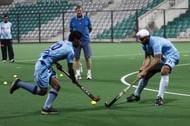Before we examine the effect of India’s playing style on its performances, we should examine the interview of the outgoing coach of the Indian national team, Michael Nobbs.
Coach Michael Nobbs is spot on when, in an interview with Chander Shekhar Luthra, DNA, he says that it will be a total disaster if we go back to playing the traditional Indian style, advocated by old Indian hockey players.
Michael Nobbs —“It’s simply the system here. India has had 30 years to fix these problems. What has the results been in last 30 years. Is there anything to be excited about?”“I am hopeful we will be able to do well by the next Olympic Games,” he added.
Does that mean India will have to wait till the 2020 Olympics to produce good results?
“Not really, if we follow the programme we laid down in last two years. But the HI and public have accepted Oltmans’s statement. Are you all ready to give him that much time? Remember, you (HI and SAI) all employed him for that only,” said Nobbs sarcastically.
The change in coach may well bring in the change of style in Indian hockey. But Nobbs is convinced that India cannot think of going back to the subcontinental style of hockey (5-3-2-1) because it could be disastrous.
“I think making the team play the Indian style of attacking hockey would be a disaster. We’ve been losing by narrow margins recently against world’s top teams. If we play with Indian style, we will be murdered 10-0 or even worse. We should be adopting Australian or Dutch style (read European style) in order to progress,” said Nobbs.
Misadventure started two years back
As mentioned in my previous article, the die was cast when the decision was made to play a more attacking Indian/Australian style hockey. A gullible, inexperienced but willing coach was hired 2 years back.
How much was his knowledge about the Indian conditions? How much did he review the tapes? Did he consult with the previous coach, Jose Brasa (under whose tutelage the team had really improved by playing a European blend of scientific hockey)?
Did he really draft his players or was he saddled with them (the omission of Vinay, Chikara, Ravipal & Mahadik & retention of “loyal” non performers like Gurbaj, Sandeep, Shivendra, Khandekar, besides many other “non-ready youngsters)?
Whose decision was it to inculcate youngsters and who decided that they were better than the ones that they replaced? How much leeway was he allowed in correcting things, once he realized things were not going right? What was the role of Hockey India, and the influence peddling Punjabi coterie, masquerading under the guise of “development of hockey committee”, the sinister games of the selection committee of the so-called ‘past Olympians’? Only he and God alone know.
Role of the journos
The journalists, in their columns, are instrumental in raising controversy – foreign coach vs Indian, different playing styles, discarded player laments, youngsters vs seniors, administrative fights, IHF versus Hockey India, court battles, et al.
Many of them have been writing on hockey and Indian hockey regularly and for many years. In the case of Mr. Thygarajan, it seems like nearly a century (I remember reading his articles on hockey in SportsStar in my teens, 40 years back). Yet, his constant comment has been “Indians have a great midfield.”
When the same midfield does not pan out to be what he says they are, he has no qualms about criticizing the overall performance, and changing the subject, yet makes no mention of the travails of “his exalted midfield”.
Moreover, he absolves himself of all responsibility of his false premise. If one has a great midfield, then naturally one would perform much better. And you can be wrong a few times, but your midfield cannot be great when the team is fighting all the time to avoid the wooden spoon. More is expected of a chronic writer of Indian hockey than this gentleman.
He’s a classic representative journo example of not knowing what is wrong with Indian hockey; not knowing where it stands. They are seeing the same things on TV or on the field as everybody else, both the winning and losing outfits. Yet, they do not have any analytical skills to determine what it is they are seeing, what works and what doesn’t.
Hence the constant publishing and seeking of comments from others. The same old Olympians viciously attack each other via poor journalists like Burkha Dutt and programs like ‘The Buck Stops Here’. Pargat Singh, Zafar Iqbal, Ashok Kumar, Balbir Singh, Viren etc. come to our mind.
Have they really vetted these sources? As if Indian hockey is also the same as this TV tamasha, where opposing counterpoints i.e. fights (sole purpose is to add to TRP ratings) are expected to improve concepts and bring about improvements desperately needed to a game that is in the ICU. Since their own knowledge is defective, they rely on others whose knowledge is even more defective. Is it not right that if an expert’s opinion is wrong all the time, he cannot be called an expert any more, and that he not be in your column any more with his quotes?
Is it not necessary to make sure that the source you have is a reliable source? Or is being an Olympian the only criteria? What about coaching experience, analytical skills, talent gauging abilities, and knowledge of strategies? Is there no journalistic honesty to be correct in what is being reported on the column?
So a penchant for TRP ratings, and really no interest in helping the field that they write about, that gives them succor and sustains their job, is the biggest problem of the hockey journalists.
Drafting the correct player
With the advent of Astroturf, which is fast and true, principles from football ruling the roost in hockey, and with the game being completely different on grass, which is really a very untrue surface, there is only one way to play modern hockey and that is the scientific way (passing becomes more important than any other aspect of the game, since the ball travels extremely fast and extremely true). A common analogy would be billiards.
The scientific way is how it is practised by top sporting nations across the world, including Spain (both hockey and football). What is needed to play on the surface is a different type of player, an all rounder, physically extremely fit, fast.
Whether an attacker, midfielder or defender, with the basics down pat – trapping, passing, defending, tackling and also dribbling – put in that order, and not in the reverse order, as is fashionable currently.
Our powers that be, including most of the old Olympians, never played on the surface, and probably were as deficient in the basics as our current lot. So they know no better.
The most accurately passing players are discarded routinely (Mahadik) and the decidedly inaccurate but good dribbling potential (Manpreet) are introduced in the national line up, irrespective of their experience.
Now, on rare occasion, that dribbling skill would translate into a match winner, no doubt, but more than likely, the inaccurate passing would lead to a lot of circle penetrations against his team, and results in a loss.
Defence wins matches
Defence wins matches in any sport. Kobe Bryant is the world’s best player and the world’s best defender, in basketball. The Germans are the world’s best defenders in hockey, and are the world champions not once but consistently.
Defence leads to turnovers and prevents dangerous attacks on one’s citadel. It also leads to regular feeding of the forward line. Consistently, and culturally, the defensive skill set has not been imbibed in Indian players at the school level.
One has to only watch 13 – 14 yr German kids being trained and see what their basics skill set is. It is easy, then, to understand why they are winners in both the senior and the junior levels, both in women’s and men’s tournaments.
The obsession with playing style
There is a misconception that playing style is going to make a difference to the fortunes of a team.
Firstly, the playing style is dependent on how the team is drafted. If you have weak midfielders, you can compensate with strong defenders and superfast good dribbling forwards. But your style would have to be to bypass the midfield and play long balls to the forwards.
In the Aussie style, with a very strong midfield, you may be able to take a little chance with your defense, since the midfield would cover up for the defensive weaknesses.
The German style is all-round, all-purpose, with solid, tight, man-to-man marking and forwards using intelligent passing to get into open gaps to put pressure on opposing defences.
Again, the team would need a bunch of all-rounders, particularly strong defenders, all over the pitch. The Dutch style would need a bunch of slick passers and a superb PC expert, with solid goalkeepers.
The Spanish-style is to have at all times all 11 players behind the ball, i.e. the crowded out defensive style. If you run your offense through a very attacking midfielder like Sardara Singh, you would then get a more attack oriented open style. Any takers for the thought that the delectable Sardara Singh is a problem and not the solution for the Indian team?
The playing style is not going to make a difference as regards the fortunes of the Indian team. A playing style can only be decided by the coach depending on the personnel in his possession, and depending upon how those personnel perform in real game situations, against opponents both weak and strong.
Proper drafting of the proper players, with the skill set needed for modern scientific hockey, is the first step to be taken. A highly “hockey educated” player is the second step. A tactically proficient player is the final step.
If a player does not meet these criteria, he does not belong on the national team, however good his dribbling skills may be, as the whole world talks about Indian players in general.
Perusal of traditional weaknesses of Indian hockey
Here is a limited list:
- Leave too many gaps
- Weak defense
- too many circle penetrations by opposing team
- Weak PC defense
- Too many missed chances
This is by no means the only comments about deficiencies in the Indian team’s performance. But isn’t it right that we need players who scored the maximum goals in local competitions, who have given away the least amount of PCs, and who are strong defenders? Should we not identify teams that routinely limit the circle penetrations of their opponents, i.e. defensive teams, and then scout their defenders?
Triumvirate of bad apples
There is a triumvirate of factors responsible for keeping Indian hockey where it is for the last 41 years. It really is a case of the blind leading the blind. None of the members of this triad of entities have answered these basic questions -what is the weakness of Indian hockey and what our own weaknesses are, and how much we are responsible for the current state of affairs.
This triumvirate consist the following:
1. The old Indian players.
2. The journalists who mouth the opinion of these exalted past Olympians as if it were gospel.
3. The administration, which micromanages Indian hockey, including the above 2, & also select a “favorite few” players.
Changing coaches, raising controversy about playing style and changing team selection at the drop of a hat on parochial grounds is not going to achieve anything. A careful introspection, looking within to one’s own faults is the order of the day. Without this, there is no hope for Indian hockey.


